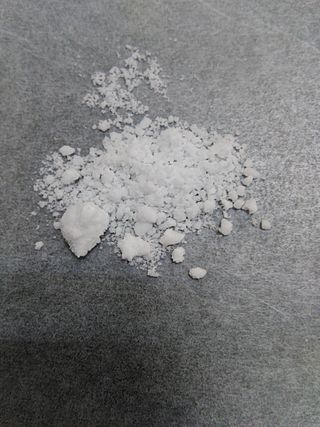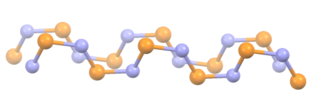Related Research Articles

Gadolinium is a chemical element; it has symbol Gd and atomic number 64. Gadolinium is a silvery-white metal when oxidation is removed. It is a malleable and ductile rare-earth element. Gadolinium reacts with atmospheric oxygen or moisture slowly to form a black coating. Gadolinium below its Curie point of 20 °C (68 °F) is ferromagnetic, with an attraction to a magnetic field higher than that of nickel. Above this temperature it is the most paramagnetic element. It is found in nature only in an oxidized form. When separated, it usually has impurities of the other rare-earths because of their similar chemical properties.
In chemistry, a nitride is an inorganic compound of nitrogen. The "nitride" anion, N3- ion, is very elusive but compounds of nitride are numerous, although rarely naturally occurring. Some nitrides have a found applications, such as wear-resistant coatings (e.g., titanium nitride, TiN), hard ceramic materials (e.g., silicon nitride, Si3N4), and semiconductors (e.g., gallium nitride, GaN). The development of GaN-based light emitting diodes was recognized by the 2014 Nobel Prize in Physics. Metal nitrido complexes are also common.

Gadolinium(III) chloride, also known as gadolinium trichloride, is GdCl3. It is a colorless, hygroscopic, water-soluble solid. The hexahydrate GdCl3∙6H2O is commonly encountered and is sometimes also called gadolinium trichloride. Gd3+ species are of special interest because the ion has the maximum number of unpaired spins possible, at least for known elements. With seven valence electrons and seven available f-orbitals, all seven electrons are unpaired and symmetrically arranged around the metal. The high magnetism and high symmetry combine to make Gd3+ a useful component in NMR spectroscopy and MRI.

Polythiazyl, (SN)x, is an electrically conductive, gold- or bronze-colored polymer with metallic luster. It was the first conductive inorganic polymer discovered and was also found to be a superconductor at very low temperatures. It is a fibrous solid, described as "lustrous golden on the faces and dark blue-black", depending on the orientation of the sample. It is air stable and insoluble in all solvents.
Praseodymium(III) nitride is a binary inorganic compound of praseodymium and nitrogen. Its chemical formula is PrN. The compound forms black crystals, and reacts with water.
Praseodymium compounds are compounds formed by the lanthanide metal praseodymium (Pr). In these compounds, praseodymium generally exhibits the +3 oxidation state, such as PrCl3, Pr(NO3)3 and Pr(CH3COO)3. However, compounds with praseodymium in the +2 and +4 oxidation states, and unlike other lanthanides, the +5 oxidation state, are also known.
Neodymium(III) nitride is a chemical compound of neodymium and nitrogen with the formula NdN in which neodymium exhibits the +3 oxidation state and nitrogen exhibits the -3 oxidation state. It is ferromagnetic, like gadolinium(III) nitride, terbium(III) nitride and dysprosium(III) nitride. Neodymium(III) nitride is not usually stoichiometric, and it is very hard to create pure stoichiometric neodymium nitride.

Europium compounds are compounds formed by the lanthanide metal europium (Eu). In these compounds, europium generally exhibits the +3 oxidation state, such as EuCl3, Eu(NO3)3 and Eu(CH3COO)3. Compounds with europium in the +2 oxidation state are also known. The +2 ion of europium is the most stable divalent ion of lanthanide metals in aqueous solution. Many europium compounds fluoresce under ultraviolet light due to the excitation of electrons to higher energy levels. Lipophilic europium complexes often feature acetylacetonate-like ligands, e.g., Eufod.
Holmium nitride is a binary inorganic compound of holmium and nitrogen with the chemical formula HoN.
Erbium nitride is a binary inorganic compound of erbium and nitrogen with the chemical formula ErN.
Ytterbium nitride is a binary inorganic compound of ytterbium and nitrogen with the chemical formula YbN.
Europium(III) nitride is a binary inorganic compound of europium and nitrogen with the chemical formula EuN.

Dypsrosium nitride is a binary inorganic compound of dysprosium and nitride with the chemical formula DyN.
Cerium nitride is a binary inorganic compound of cerium and nitrogen with the chemical formula CeN.
Lanthanum nitride is a binary inorganic compound of lanthanum and nitride with the chemical formula LaN.
Promethium nitride is a binary inorganic compound of promethium and nitrogen with the chemical formula PmN.
Protactinium nitride is a binary inorganic compound of protactinium and nitrogen with the chemical formula PaN.
Terbium nitride is a binary inorganic compound of terbium and nitrogen with the chemical formula TbN.
Lutetium nitride is a binary inorganic compound of lutetium and nitrogen with the chemical formula LuN.
Thulium nitride is a binary inorganic compound of thulium and nitrogen with the chemical formula TmN.
References
- ↑ Haynes, William M. (22 June 2016). CRC Handbook of Chemistry and Physics. CRC Press. pp. 4–63. ISBN 978-1-4987-5429-3 . Retrieved 6 February 2024.
- ↑ "Gadolinium(III) Nitride GdN". American Elements . Retrieved 6 February 2024.
- ↑ Yaws, Carl L. (20 June 2014). Thermophysical Properties of Chemicals and Hydrocarbons. William Andrew. p. 358. ISBN 978-0-323-29060-9 . Retrieved 6 February 2024.
- ↑ Li, D. X.; Haga, Y.; Shida, H.; Suzuki, T. (2 April 1994). "Magnetic properties of ferromagnetic GdN". Physica B: Condensed Matter . 199–200: 631–633. doi:10.1016/0921-4526(94)91928-3. ISSN 0921-4526 . Retrieved 6 February 2024.
- ↑ "Gadolinium(III) nitride, 99.5% (REO), Thermo Scientific Chemicals | Fisher Scientific". Fischer Scientific. Retrieved 6 February 2024.
- ↑ "Gadolinium (III) Nitride Powder (GdN) (CAS No. 25764-15-2)". samaterials.com. Retrieved 6 February 2024.
- ↑ Perry, Dale L. (19 April 2016). Handbook of Inorganic Compounds. CRC Press. p. 181. ISBN 978-1-4398-1462-8 . Retrieved 6 February 2024.
- ↑ Standard X-ray Diffraction Powder Patterns. U.S. Department of Commerce, National Bureau of Standards. 1953. p. 57. Retrieved 6 February 2024.
- ↑ "Gadolinium Nitride Powder, GdN, CAS 25764-15-2 - Heeger Materials". Heeger Materials Inc. Retrieved 6 February 2024.
- 1 2 "Gadolinium Nitride Powder GdN, CAS No 25764-15-2". CG MATERIAL. Retrieved 6 February 2024.
- ↑ O'Bannon, Loran (6 December 2012). Dictionary of Ceramic Science and Engineering. Springer Science & Business Media. p. 115. ISBN 978-1-4613-2655-7 . Retrieved 6 February 2024.